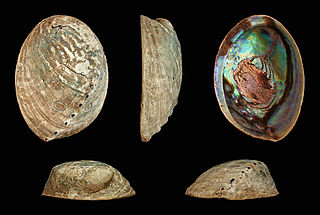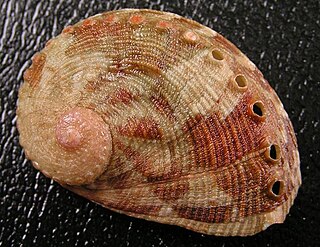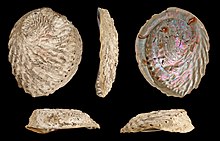
Abalone is a common name for any of a group of small to very large marine gastropod molluscs in the family Haliotidae. Other common names are ear shells, sea ears, and, rarely, muttonfish or muttonshells in parts of Australia, ormer in the UK, perlemoen in South Africa, and paua in New Zealand. Abalones are marine snails. Their taxonomy puts them in the family Haliotidae, which contains only one genus, Haliotis, which once contained six subgenera. These subgenera have become alternative representations of Haliotis. The number of species recognized worldwide ranges between 30 and 130 with over 230 species-level taxa described. The most comprehensive treatment of the family considers 56 species valid, with 18 additional subspecies. The shells of abalones have a low, open spiral structure, and are characterized by several open respiratory pores in a row near the shell's outer edge. The thick inner layer of the shell is composed of nacre (mother-of-pearl), which in many species is highly iridescent, giving rise to a range of strong, changeable colors which make the shells attractive to humans as decorative objects, jewelry, and as a source of colorful mother-of-pearl. The flesh of abalones is widely considered to be a desirable food, and is consumed raw or cooked by a variety of cultures.

Haliotis australis, common name the queen pāua,yellowfoot pāua, or austral abalone, is a species of edible sea snail, a marine gastropod mollusk in the family Haliotidae, the abalones.

Haliotis iris, common name pāua, blackfoot pāua or rainbow abalone, is a species of edible sea snail, a marine gastropod mollusk in the family Haliotidae, the abalones.

Haliotis laevigata, common name the smooth Australian abalone or greenlip abalone or whitened ear shell, is a species of sea snail, a marine gastropod mollusk in the family Haliotidae, the abalones.

The pink abalone, scientific name Haliotis corrugata, is a species of large edible sea snail, a marine gastropod mollusk in the family Haliotidae, the abalones.

The blood-spotted abalone is a species of edible sea snail, a marine gastropod mollusk in the family Haliotidae, the abalones. This species is common on rocky shores on the coast of South Africa.

The blacklip abalone, Haliotis rubra, is an Australian species of large, edible sea snail, a marine gastropod mollusk in the family Haliotidae, the abalones.

Haliotis gigantea, common name the giant abalone, is a species of sea snail, a marine gastropod mollusk in the family Haliotidae, the abalones. It is also known as Siebold's abalone, after Philipp Franz von Siebold.

Haliotis coccoradiata, common name the reddish-rayed abalone, is a species of sea snail, a marine gastropod mollusk in the family Haliotidae, the abalones.

Haliotis cyclobates, common name the whirling abalone or the circular ear shell, is a species of sea snail, a marine gastropod mollusk in the family Haliotidae, the abalones.

Haliotis mariae is a species of sea snail, a marine gastropod mollusk in the family Haliotidae, the abalones.

Haliotis ovina, common name the sheep's ear abalone, is a species of sea snail, a marine gastropod mollusk in the family Haliotidae, the abalones.

Haliotis pulcherrima is a species of sea snail, a marine gastropod mollusk in the family Haliotidae, the abalones.

Haliotis roei, common name Roe's abalone, is a species of sea snail, a marine gastropod mollusk in the family Haliotidae, the abalones.

Haliotis scalaris, common name the staircase abalone or the ridged ear abalone, is a species of sea snail, a marine gastropod mollusk in the family Haliotidae, the abalones.

Haliotis stomatiaeformis is a species of sea snail, a marine gastropod mollusc in the family Haliotidae, the abalones. It is endemic to a small portion of the Mediterranean Sea, off the coasts of Sicily and Malta.

Haliotis clathrata, common name the lovely abalone, is a species of sea snail, a marine gastropod mollusc in the family Haliotidae, the abalones.

Haliotis marmorata is a species of sea snail, a marine gastropod mollusk in the family Haliotidae, the abalones.

Haliotis parva, common name the canaliculate abalone, is a species of sea snail, a marine gastropod mollusk in the family Haliotidae, the abalones.

Haliotis, common name abalone, is the only genus in the family Haliotidae.


























